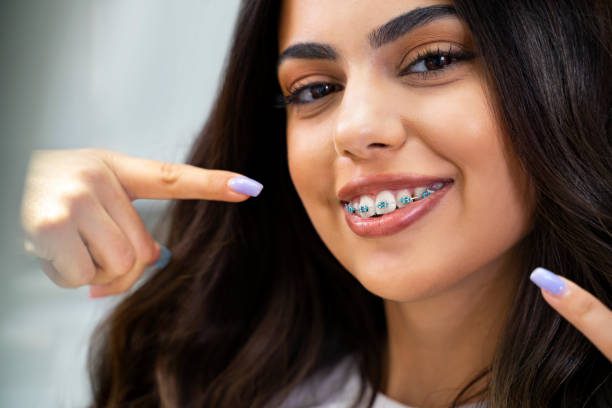⚠️ Medical Disclaimer
Important: This content is for informational and educational purposes only. It should not be used as a substitute for professional medical advice, diagnosis, or treatment. Always consult with a qualified healthcare provider before making changes to your diet, taking supplements, or if you have questions about a medical condition. Never disregard professional medical advice or delay seeking it because of information you read here.
Last Updated on January 11, 2024 by Grace Oluchi
Welcome to the world of dental braces, where a beautiful and confident smile awaits you! Whether you’re considering braces for yourself or a loved one, understanding the various types of dental braces available today can help you make an informed decision. In this article, we will delve into the fascinating world of orthodontics, exploring the different types of dental braces and their unique benefits. So, let’s embark on this journey towards a perfectly aligned smile!
What are Dental Braces?
Dental braces, also known as orthodontic braces, are an effective and widely used orthodontic treatment designed to correct misaligned teeth and help achieve a straight, beautiful smile. They consist of various components, including brackets, arch wires, and elastic bands, all working together to exert gentle pressure on the teeth, gradually moving them into their desired positions.
The primary objective of dental braces is to correct malocclusions, which are dental misalignments such as overcrowding, gaps, crooked teeth, or bite issues like overbite, underbite, or crossbite. By applying consistent and controlled forces, braces guide the teeth into proper alignment, improving both their appearance and functionality. This can have substantial long-term benefits, such as enhanced oral health, improved chewing and speech abilities, and reduced risk of dental complications.
The process of orthodontic treatment with braces typically begins with a thorough examination by a qualified orthodontist. They will create a personalized treatment plan based on the patient’s specific needs, taking into account the current condition of their teeth and jaw. The braces are then carefully attached to the teeth using adhesive, and the archwires are placed to facilitate tooth movement. Periodic adjustments are made during follow-up visits to gradually shift the teeth into their liking positions.
Although the duration of orthodontic treatment can vary depending on the complexity of the case, it should last from several months to a few years. Regular dental check-ups and diligent oral hygiene practices, including brushing and flossing, are essential to maintain the health of the teeth and gums during this period. Once the treatment is complete, the patient may need to wear retainers to help maintain the newly achieved alignment.
Dental braces are an invaluable tool in the field of orthodontics, providing a reliable and efficient means of correcting dental misalignments. With their ability to address a wide range of issues and produce remarkable results, braces play a crucial role in improving both the aesthetics and functionality of the teeth, ultimately contributing to a confident and healthy smile.
How Does Dental Braces Work?
- At the core of braces are the brackets, small metal or ceramic attachments that are carefully bonded to the front surface of the teeth. These brackets act as anchors for the braces and serve as attachment points for the archwires. The archwires, made of high-quality materials, are connected to the brackets and play a vital role in the tooth movement process.
- As the orthodontic journey begins, the arch wires are skillfully ran through the brackets and put in place. Initially, the wires may be quite flexible, allowing for ease of placement. However, as the treatment progresses, the wires are adjusted and changed periodically to gradually increase the level of pressure exerted on the teeth.
- The magic of dental braces lies in this gentle pressure. When the arch wires are tight, they create a controlled force that nudges the teeth in the desired direction. This consistent pressure stimulates the surrounding bone, initiating a process known as bone remodeling. Over time, the bone adjusts and reshapes itself, accommodating the tooth movement and allowing for a stable, long-lasting result.
- To aid in the tooth movement process, additional components such as elastic bands or tiny springs may be in use. These small yet powerful tools apply specific forces to address specific dental issues, such as correcting bite discrepancies or closing gaps between teeth. Each adjustment and modification contribute to the overall progress towards a straighter, healthier smile.
- It’s essential to note that dental braces work gradually, as teeth need time to respond and adapt to the forces applied. This means that patience and cooperation are key throughout the treatment journey. Regular visits to the orthodontist ensure that progress is monitored, adjustments are made, and the treatment plan is tailored to your unique needs.
Types of Dental Braces.
There are several types of dental braces available, each with its unique features and advantages. Let’s explore some of the most common types:
- Traditional Metal Braces:


These are the most recognizable type of braces and consist of metal brackets attached to the front surface of the teeth. Connected by arch wires and secured with colorful elastic bands, metal braces apply gentle pressure to gradually shift the teeth into proper alignment. They are highly effective and suitable for treating a wide range of orthodontic issues.
- Ceramic Braces:
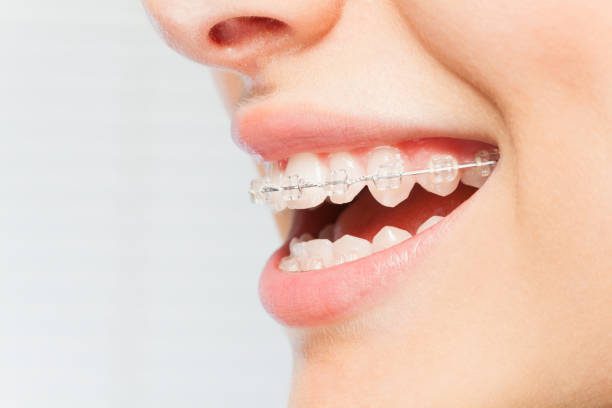

This type of braces works similarly to metal braces but uses tooth-colored or clear ceramic brackets instead. The ceramic material blends with the natural color of teeth, making them less noticeable. Ceramic braces are an excellent option for those who desire a more discreet treatment while still achieving effective tooth movement.
- Lingual Braces:
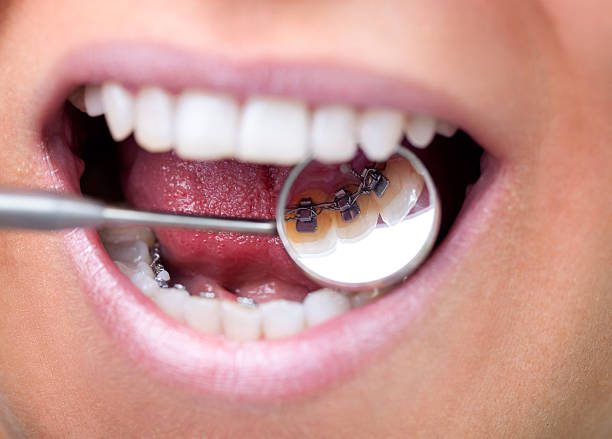

Lingual braces are truly hidden braces as they are placed on the back (lingual) surface of the teeth. Custom-made for each patient, lingual braces utilize metal brackets and wires to correct misalignments. Their discreet positioning makes them virtually invisible from the front, making them popular among individuals seeking a highly aesthetic treatment option.
- Clear Aligners:
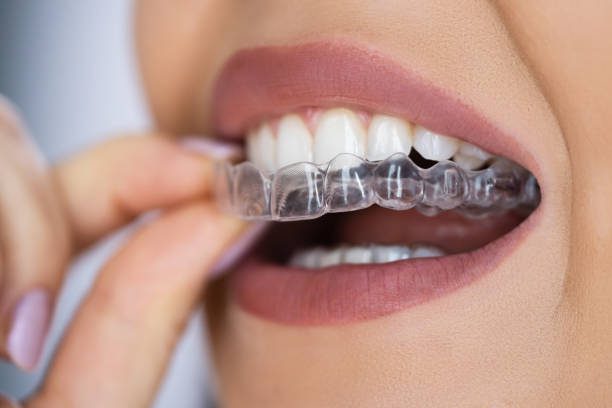

Unlike traditional braces, clear aligners are removable and made of transparent plastic material. Custom-designed for each patient, these aligners apply controlled forces to gradually move the teeth into alignment. Clear aligners are nearly invisible, comfortable to wear, and offer the convenience of being able to remove them for eating, brushing, and special occasions.
What Age Is the Best for Dental Braces?
The ideal age for dental braces can vary depending on the individual’s specific orthodontic needs. In general, braces can be good for children, teenagers, and adults.
For children, it is wise to have an initial orthodontic evaluation by the age of 7. At this stage, the orthodontist can identify any potential orthodontic issues and determine if early intervention, such as using expanders or other devices, is necessary. However, braces are typically applied during the teenage years when most of the permanent teeth have erupted, usually between the ages of 10 and 14.


Teenagers often opt for braces as their jaw and facial bones are still growing, making it easier to guide the teeth into their proper positions. Additionally, many of their peers may also be undergoing orthodontic treatment, making it a socially comfortable time for them to wear braces.
However, it’s worth mentioning that braces are not limited to teenagers. Adults of any age can benefit from orthodontic treatment. With advancements in orthodontic technology, options like clear aligners or more discreet ceramic braces have made it easier for adults to undergo treatment without compromising aesthetics.
Ultimately, the best age for dental braces is determined on an individual basis. It is advisable to consult with an orthodontist who can assess your specific orthodontic needs and recommend the most appropriate time to begin treatment. Remember, it’s never too late to achieve a straighter and healthier smile!
How Long Does Dental Braces Take to Work?
The duration of orthodontic treatment with dental braces varies depending on several factors, including the complexity of the case, the age of the patient, and the specific goals of treatment. On average, braces are typically worn for a period of 1 to 3 years. However, it’s important to note that individual cases may differ, and the orthodontist will provide a more accurate estimate after evaluating your specific situation.
During the treatment process, regular visits to the orthodontist are necessary for adjustments and progress checks. These visits usually occur every 4 to 8 weeks, allowing the orthodontist to monitor the movement of the teeth and make any necessary modifications to the braces or wires.
It’s essential to understand that orthodontic treatment requires time and patience. The teeth need sufficient time to respond to the gentle pressure applied by the braces, and the bone surrounding the teeth needs to remodel and stabilize in their new positions. Rushing the process can lead to potential complications or an unstable result.
Remember, the ultimate goal is to achieve a healthy, stable, and aesthetically pleasing smile. While the treatment duration may seem lengthy, the long-term benefits of properly aligned teeth and an improved bite make the investment worthwhile.
It’s best to consult with an experienced orthodontist who can evaluate your specific case, provide an estimated treatment duration, and guide you through the journey to a straighter smile.
Benefits of Dental Braces.
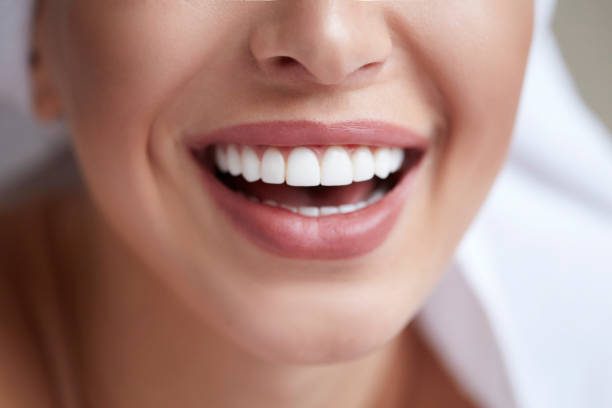

- Improved Oral Health: Dental braces help correct misaligned teeth, lessen overcrowding and closing gaps. This alignment boost helps better oral hygiene practices, making it easier to brush and floss well. Straight teeth are less prone to plaque buildup and are less likely to develop dental issues like tooth decay or gum disease.
- Enhanced Bite Function: Braces can address bite problems, such as overbite, underbite, or crossbite, helping the overall function of the bite. By aligning the teeth properly, braces ease efficient chewing and reduce the risk of jaw joint disorders or excessive tooth wear.
- Increased Confidence: A straight and beautiful smile can significantly boost self-esteem and confidence. Dental braces can correct crooked teeth, close gaps, and create a more beautiful smile, helping individuals to feel more comfortable and confident in social and professional settings.
- Speech Improvement: Misaligned teeth can affect speech patterns and pronunciation. Braces can help align the teeth and jaws, helping clarity and tone, leading to better speech and communication skills.
- Reduced Risk of Dental Injuries: Protruding or misaligned teeth are more open to damage during accidents or sports activities. By aligning the teeth properly, braces can reduce the risk of dental injuries, protecting the teeth from potential trauma.
- Long-Term Dental Stability: Orthodontic treatment with braces aims to achieve a stable bite and alignment. This balance reduces the likelihood of future dental issues, such as excessive tooth wear, jaw problems, or moving of teeth, helping to maintain a healthy smile in the long run.
- Aesthetically Pleasing Smile: One of the most visible benefits of dental braces is the aid in the appearance of the smile. By straightening and aligning the teeth, braces create a more attractive and uniform smile, helping facial aesthetics and overall attractiveness.
Side Effects of Dental Braces.
While dental braces offer numerous benefits, it is important to be aware of potential side effects that may arise during braces treatment. Here are some common side effects of dental braces:
- Pain and Sores: It is common to experience some pain and sores after braces are initially placed or adjusted. This pain may last for a few days as the teeth and jaws adjust to the new pressure. Over-the-counter pain relievers and orthodontic wax can help lower any pain.
- Soft Tissue Irritation: Braces have parts such as brackets, wires, and elastic bands that may occasionally cause irritation or sore spots on the gums, cheeks, or lips. Orthodontic wax can be used to create a cover barrier and lower the irritation. Proper oral hygiene, including regular brushing and flossing, is crucial to prevent inflammation or infections.
- Speech Changes: Initially, braces may affect speech patterns or cause a slight lisp as the tongue adjusts to the presence of the braces. However, most individuals adapt quickly, and speech returns to normal within a short period of time.
- Difficulty Eating Certain Foods: Certain hard, sticky, or chewy foods may pose challenges while wearing braces. It is wise to avoid these foods to prevent damage to the braces or teeth. Your dentist will provide a guide on dietary restrictions during treatment.
- Tooth Discoloration or change: Improper oral hygiene during orthodontic treatment can lead to tooth discoloration or change. This occurs when plaque builds up around the brackets, causing white spots or permanent stains on the teeth. Thorough brushing, flossing, and regular dental cleanings help prevent these issues.
- Increased Risk of Dental Decay: Braces create more areas where food bits can get trapped, adding to the risk of dental decay if proper oral hygiene practices are not followed. Regular brushing, flossing, and the use of interdental brushes or water flossers can help maintain good oral hygiene.
- Allergic Reactions: In rare cases, individuals may experience allergic reactions to certain parts of braces, such as latex or metals. It is important to inform your dentist of any known allergies before treatment begins.
Do Dental Braces Hurt?
During the course of dental treatment with dental braces, it is common to experience some pain or sores. However, the level of pain varies from person to person and can depend on several factors, including one’s pain tolerance, the type of braces used, and the specific stage of treatment.
When braces are initially placed or after they are adjusted, it is common to feel some sores or pressure on the teeth and gums. This pain is usually described as a dull ache or sensitivity, similar to the feeling after a dental cleaning.
The pain usually lasts for a few days as the teeth and area tissues adjust to the pressure exerted by the braces. Eating softer foods, using over-the-counter pain relievers, and putting dental wax to any areas causing irritation can help lower the pain.
It’s important to note that pain following braces tends to decrease over time as the mouth adapts to the continuous pressure. Most individuals find that any pain or sores experienced during dental treatment is doable and well worth the long-term benefits of a straight and healthy smile.
If the pain becomes severe or continues for a longer period, it is wise to contact your dentist to guide you and to ensure there are no base issues.
How to Care for Your Dental Braces.
Proper care and maintenance of dental braces are important to ensure the success of your orthodontic treatment. Here are some important tips to help you care for your braces properly:
- Maintain Excellent Oral Hygiene: Brushing and flossing become even more crucial when wearing braces. Brush your teeth after every meal or snack, using a soft-bristled toothbrush and fluoride toothpaste. Pay special attention to properly clean around the brackets, wires, and gumline. Flossing with threaders, floss picks, or interdental brushes is important to remove food bits and plaque from between the teeth and braces.
- Use Orthodontic Tools: Your orthodontist may provide specialized tools such as interdental brushes, floss threaders, or water flossers to aid in cleaning hard-to-reach areas. Follow the guide on how to use these tools well.
- Be Mindful of Your Diet: Avoid foods that are hard, sticky, or chewy, as they can damage the braces or get stuck in them. Opt for softer foods and cut larger items into smaller, doable pieces. Also, avoid bad habits like chewing on ice or biting pens, as they can cause damage to the braces.
- Protect Your Braces During Physical Activities: If you do sports or activities where there is a risk of injury to the mouth, consider wearing a mouthguard. Your dentist can recommend the best type of mouthguard to protect your braces and teeth.
- Attend Regular Orthodontic Check-ups: Keep up with your timed dental appointments for changes and progress checks. These visits allow your dentist to monitor your progress, make necessary changes and address any concerns or issues that may arise.
- Inform your Orthodontist of any Problems: If you experience any issues with your braces, such as loose brackets or wires, pain, or irritation, contact your dentist early. They can provide a guide over the phone or schedule an emergency appointment if necessary.
- Follow Your Orthodontist’s Instructions: Your dentist will provide specific instructions on how to care for your braces. It’s important to follow their advice regarding wearing elastics, stopping certain foods or habits, and any other specific rules they provide.
What to Eat While Using Dental Braces.


With dental braces, it’s best to choose soft and easy-to-chew foods. Some examples include:
- Cooked vegetables,
- Soft fruits,
- Tender meats,
- Pasta,
- Rice,
- Yogurt,
- Smoothies,
- Soups.
Remember to cut food into smaller, bite-sized pieces to make eating more comfortable.
How to Maintain Results After Dental Braces.
To maintain the results after braces, consider the following tips:
- Wear your retainer as said by your dentist. This helps prevent your teeth from moving back to their original positions.
- Follow a regular oral hygiene routine. Brush your teeth at least twice a day, floss daily, and use mouthwash to keep your teeth and gums healthy.
- Avoid habits that can negatively impact your teeth, such as nail-biting, chewing on pens, or opening packages with your teeth.
- Limit eating of sugary foods and drinks, as they can add to tooth decay and enamel erosion.
- Visit your dentist regularly for tests and professional cleanings to maintain oral health.
- Consider wearing a mouthguard during physical activities or contact sports to protect your teeth from potential damage.
- Practice good posture and avoid pressure on your teeth, such as biting on hard objects or grinding your teeth.
- Be mindful of what you eat. Avoid hard, sticky, or chewy foods that can actually damage your teeth or dental work.
- Stay in touch with your dentist and address any concerns or issues early to ensure durable results.
When to Call Your Dentist or Orthodontist?
You should contact your dentist if you experience any of the following issues while using dental braces:
- Severe pain or ache that continues even after taking over-the-counter pain relievers.
- Broken or loose brackets, wires, or bands.
- Poking or irritating wires that are causing pain or mouth sores.
- Injuries or accidents that affect your braces or teeth.
- Swelling, bleeding, or infection in the gums or mouth.
- Significant changes in your bite or alignment of teeth.
- Persistent difficulty in chewing or speaking.
- Any concerns or questions regarding your treatment progress or oral hygiene routine.
Invisalign or Dental Braces? Which Option is Right for Me?
The choice between Invisalign and traditional dental braces depends on various factors. Here are some thoughts to help you decide:
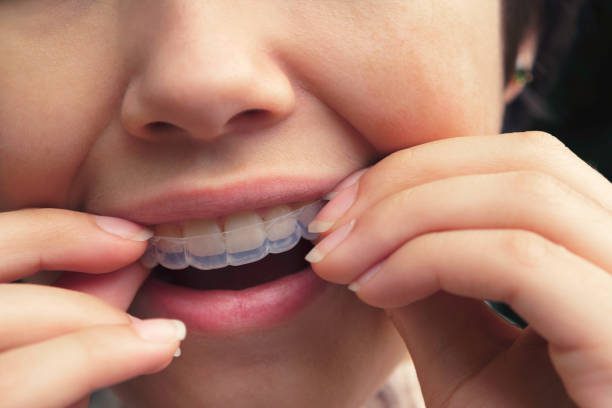

- Visibility: If you prefer a more secret option, Invisalign uses clear aligners that are nearly invisible, while traditional braces are more visible.
- Treatment Complexity: Invisalign is better for mild to moderate dental issues, while traditional braces can handle a wider range of complex cases.
- Comfort: Invisalign aligners are removable, aiding easier eating and oral hygiene. Traditional braces may cause initial pain and require changes.
- Compliance: Invisalign aligners must be worn for 20-22 hours a day, needing discipline and responsibility. Traditional braces are fixed and don’t require user agreement.
- Lifestyle Considerations: Invisalign aligners can be removed for special occasions, sports, or playing musical tools. Traditional braces are always in place.
- Treatment Duration: In some cases, traditional braces may achieve results faster than Invisalign, but it varies depending on individual circumstances.
To determine the right option for you, consult with a dentist who can check your specific needs, assess your oral health, and provide a personalized plan based on your goals and liking.
Can I Buy Special Floss for Dental Braces?
Yes, you can buy special floss designed specifically for dental braces. It is commonly known as orthodontic or braces floss. This type of floss has certain parts that make it easier to move around the brackets and wires of braces.
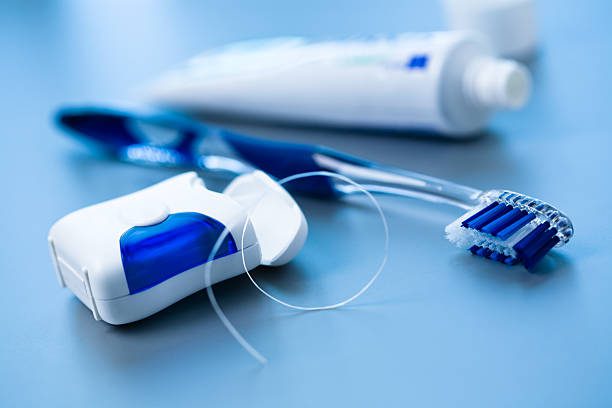

Orthodontic floss is usually thicker and sturdier than regular floss, allowing it to withstand the pressure applied when flossing between the braces. It may have a stiff end or a built-in threader to help guide the floss between the brackets. Some brands also offer floss picks or pre-threaded flossers designed for braces.
Using specialized floss can make the process of cleaning between the teeth and around the braces easier and effective. Your dentist can recommend specific brands or types of floss that would work best for your braces.
Can You Chew Gum with Dental Braces?
It is generally wise to avoid chewing gum while wearing braces. Chewing gum can pose a few challenges when it comes to braces:
- Sticky Residue: Gum can stick to the brackets and wires, making it difficult to clean and potentially causing damage when trying to remove it.
- Bracket Displacement: Chewing gum can dislodge or loosen the brackets, affecting the alignment of your teeth and potentially prolonging the overall treatment time.
- Wire Distortion: The forceful chewing motion can bend or distort the wires, resulting in pain and requiring additional changes by your orthodontist.
However, some dentists may allow sugar-free gum in moderation as long as you follow specific rules. It’s important to consult with your orthodontist about their rules regarding gum chewing during your treatment. They can provide personalized advice based on your specific orthodontic needs.
The Key Takeaway.
Dental braces offer numerous benefits for individuals seeking to improve their oral health, smile aesthetics, and overall well-being. They can address a variety of orthodontic issues, such as misaligned teeth, bite problems, and spacing concerns. By undergoing orthodontic treatment with braces, you can experience better oral hygiene, better bite function, increased confidence, and improved speech. Additionally, braces can help reduce the risk of dental injuries. It can also promote long-term dental stability and create a more aesthetically pleasing smile.


While there are some side effects of braces, proper care and regular visits to the orthodontist can manage them effectively. By following proper oral hygiene practices and promptly addressing any concerns, you can ensure the success of your orthodontic treatment.
Orthodontic treatment with braces is not limited to a specific age group, everyone can benefit from this form of treatment. It is important to consult with an experienced orthodontist who can evaluate your specific orthodontic needs. They can guide you through the process of achieving a straighter, healthier smile.
Ultimately, dental braces offer a valuable solution for individuals seeking to improve their oral health, function, and appearance. With patience and guidance from an orthodontic, braces can help you achieve a beautiful smile that lasts a lifetime.
How long does the typical braces treatment last?
The duration of braces treatment varies depending on individual factors, but typically it lasts between 1 to 3 years. Your orthodontist will provide a more accurate estimate based on your specific needs.
Can I still play sports or musical instruments while wearing braces?
Absolutely! You can still engage in sports and play musical instruments while wearing braces. It’s important to wear a mouthguard during physical activities to protect your braces and teeth from potential impact.
Are there any foods I need to avoid while wearing braces?
While wearing braces, it’s generally advised to avoid sticky, hard, or chewy foods that could damage the brackets or wires. Examples include chewing gum, hard candies, popcorn, and tough meats. Your orthodontist will provide a comprehensive list of foods to avoid.
What should I do if a bracket or wire from my braces becomes loose or breaks?
If a bracket or wire becomes loose or breaks, contact your orthodontist immediately. They will guide you on what steps to take, which may include scheduling an appointment for repair. It’s essential not to attempt fixing it yourself to avoid further complications.
How often do I need to visit the orthodontist for braces adjustments?
Typically, orthodontic adjustments are scheduled every 4 to 8 weeks. During these visits, your orthodontist will make necessary modifications to your braces, such as tightening wires, or adjusting brackets. The frequency of adjustments may vary based on your treatment plan.
Can braces fix both cosmetic and functional issues with my teeth?
Yes, braces can address both cosmetic and functional issues. They can correct misaligned teeth, overcrowding, gaps, and bite problems. Your orthodontist will evaluate your specific concerns and create a treatment plan tailored to your needs.
Are there alternatives to traditional metal braces, such as clear aligners?
Yes, there are alternatives to traditional metal braces, such as clear aligners. Clear aligners are transparent, removable, and gradually shift your teeth into place. They offer a more discreet option, but not everyone is a candidate. Consult your orthodontist to determine the most suitable treatment for you.
What are the potential risks or complications associated with braces?
While braces are generally safe, there are potential risks and complications. These can include tooth decay, gum disease, discomfort, mouth sores, or temporary changes in speech. Regular dental hygiene, following orthodontist’s instructions, and attending scheduled appointments help minimize these risks.
How can I maintain good oral hygiene while wearing braces?
Maintaining good oral hygiene is crucial while wearing braces. Brush your teeth thoroughly after every meal, using special orthodontic brushes or interdental brushes to clean around brackets and wires. Flossing with threaders or floss picks is also important to remove food particles. Your orthodontist will provide detailed instructions on proper oral care.
Will wearing braces be uncomfortable or painful?
Initially, wearing braces may cause some discomfort or soreness as your teeth adjust. It’s normal to experience mild pressure or sensitivity. Over-the-counter pain relievers and rinsing with warm saltwater can help. Any severe or persistent pain should be discussed with your orthodontist, as adjustments may be needed for greater comfort.

